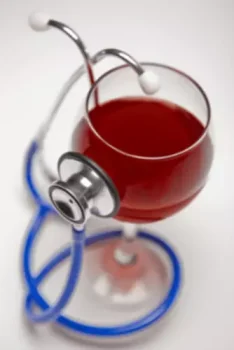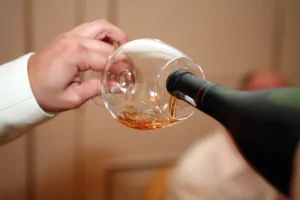The hypothesis that atypical antipsychotics may decrease alcohol intake are supported by two separate studies with risperidone and olanzapine in high‐alcohol‐preferring rats [154, 155]. Neither compound had an effect on maintenance of chronic alcohol drinking [157], which is in line with a study showing that clozapine did not reduce alcohol consumption in alcohol‐preferring rats [155]. These atypical antipsychotics have a significantly improved side effect profile compared to the traditional first generation of dopamine D2 antagonists. Thus, there has been a renewed interest in evaluating these medications as potential treatment for alcohol dependence with the assumption that the atypical antipsychotics might reduce craving and consumption of alcohol without the substantial adverse effect profile [152]. Furthermore, they are clinically used for alcohol‐dependent patients during the acute detoxification phase to prevent agitation, hallucinations and delirium tremens [153]. Studies elucidating the underlying mechanism of action of the complex dopamine–alcohol interaction have been conducted.

The development of compulsive coping behavior depends on dorsolateral striatum dopamine-dependent mechanisms
Dopamine uptake was also enhanced in females, but not males (regardless of abstinence state). We also found that dopamine D2/3 autoreceptor function was reduced in male, but not female, alcohol drinkers relative to control groups. Finally, we found that blockade of nicotinic acetylcholine receptors inhibited evoked dopamine release in nonhuman primates.
How Does Alcohol Affect Dopamine Levels?
- Altogether, our findings demonstrate that long-term alcohol consumption can sex-dependently alter dopamine release, as well as its feedback control mechanisms in both DS subregions.
- This phenomenon has also been investigated using the brain age paradigm, an approach that investigates healthy brain aging by estimating chronological age from neuroimaging data and examines the difference between an individual’s predicted and actual age [39].
- However, D1 receptors activate Gs proteins thereby increasing cAMP, whereas D2 receptors activate Gi proteins thereby decreasing cAMP.
- Currently, due to the knowledge of the addictive potential of dopamine agonists, combined with the lack of consistent findings from clinical studies, it is suggested that dopamine receptor agonists do not hold promise as a treatment for alcohol dependence.
This phenomenon has also been investigated using the brain age paradigm, an approach that investigates healthy brain aging by estimating chronological age from neuroimaging data and examines the difference between an individual’s predicted and actual age [39]. One study found that individuals with alcohol dependence showed a difference of up to 11.7 years between their chronological and predicted biological age based on their grey matter volume [33]. Crucially, the difference showed a linear increase with age and was at its greatest in old age which further offers support to the notion of a greater vulnerability to the effects of alcohol in later life. GABA or GABA is the third neurotransmitter whose functioning is critical in understanding the genetics of alcohol addiction. Recently, two sub types of the GABAA receptor have come into the spotlight for showing what can possibly be a genetic predisposition to alcohol addiction. These two subtypes are namely GABA A receptor α1 (GABRA1) and GABA A receptor α6 (GABRA6).
International Patients
Doctors believe this may result in irregular dopamine messaging in a part of the brain involved with movement control. Some medications that can cause tardive dyskinesia include antipsychotics, which doctors use to treat schizophrenia and other mental health conditions. When dopamine levels are typical, they promote good health, while atypical levels can lead to health concerns.
Beverage effects on FC

Stopping alcohol use and treating psychotic symptoms with antipsychotic medications can successfully treat alcohol-use psychosis. They can’t be attributed to any other cause, like another underlying mental health condition. When this happens, it’s known as “secondary psychosis,” meaning it’s psychosis occurring secondary to another condition. In this case, psychosis alcohol and dopamine is secondary to intoxication, withdrawal, or alcohol use disorder (AUD). The results of the aforementioned study was therefore in complete contrast to the results published by[60] which found a positive correlation of the short (S) allele with binge-drinking behavior, drinking more alcohol per occasion, as well as drinking to get drunk more often.
- Alcohol is thought to activate microglia partially via TLR4 receptors, indeed TLR4 deficiency protected against alcohol induced glial activation and neurotoxicity in a rodent model of chronic alcohol consumption [89].
- “There’s a great deal of doubt about whether the atrophy seen on MRI is due to loss of brain cells or to fluid shifts within the brain.” He explains that this type of atrophy shows major improvements within weeks when alcoholics stop drinking, which wouldn’t be the case if it were caused by brain cell death.
- Further research aimed at clarifying the interaction between the DA system, the glutamatergic system and other neurotransmitter systems is needed before it will be possible to improve the effectiveness of interventions for preventing and treating alcohol dependence.
- Psychotic symptoms include hallucinations, delusions, disorganized thinking and movement, and what is known as “negative symptoms,” which involve withdrawal and a lack of interest.
- “We have known for a long time that alcoholism runs in families, which implies a genetic risk,” said Dr. Raymond F. Anton, Distinguished Professor and director of the Center for Drug and Alcohol Programs at the Medical University of South Carolina.
How does the brain change as AUD develops?
